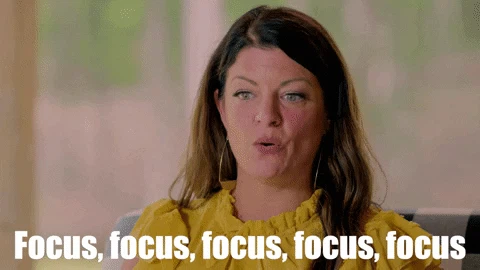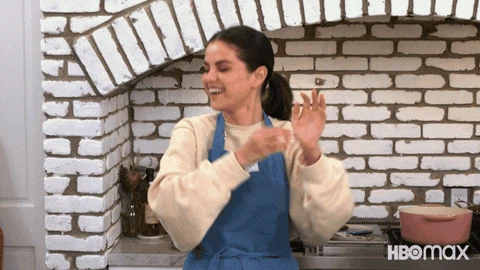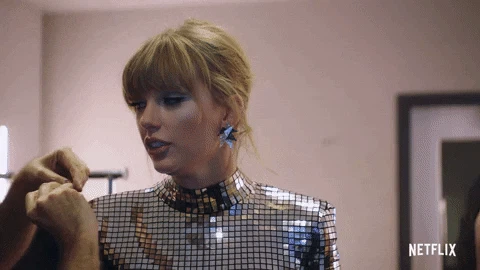New Year, New You? Here’s How To *Actually* Stick To Your Fitness Goals In 2023
Hey, Evie girl, this year is the year you’re going to do it. You’ve already made up your mind that you want to get fit (or fitter), and I’m going to be right here on the sidelines cheering you on.

It’s in our human design to pick a routine and stick to it, and for some of us that routine isn’t always so friendly toward our figures. Making a conscious change and dedicating yourself to a revitalized fitness goal is going to take some long-term commitment on your part because you’re essentially rewiring your mind.
Sticking to fitness goals as a New Year’s resolution might seem like an uphill battle that you’ll give up on come Valentine's Day. The good news is if you make thoughtful changes in your day-to-day life, thereby creating new habits, you’ll eventually find it’s just as hard to break those positive habits as it was to break the old ones. Ready to get going? Let’s jump right in!
Narrow Your Focus
Alright, I know you’re eager to conquer the world, but let’s be real: That “New Year, New Me” mindset where you go all-in on motivation isn’t super sustainable. While you should definitely be enthusiastic about turning over a new leaf in your health and wellness journey, you shouldn’t overwhelm yourself. There’s an element of truth to that old adage “you can’t teach an old dog new tricks” because deep-rooted habits are hard to reverse.
It’s not impossible to change your habits either though! You can achieve more if you narrow your focus to a few solid goals instead of attempting to do a total 180. Pick three or so fitness-related goals that are realistic, fit into your work-life balance, and can be managed without sacrificing anything that’s important to you. The National Academy of Sports Medicine uses the SMART goal philosophy, meaning that goals are more attainable if they are “specific, measurable, attainable, realistic, and time-specific.”

Need an example of a goal that’s focused and purposeful? Maybe you want to get stronger. That’s pretty vague, isn’t it? What if you instead want to squat double your bodyweight by the end of the year? You’ll have to progressively overload throughout the year, you’ll be on a deadline, and you can easily measure how your squats improve throughout the year.
Make It Impossible To Avoid the Task at Hand
Out of sight, out of mind, right? I once was so bothered by the fact that I couldn’t remember to take my vitamins, I made it stupidly simple to remember by incorporating them into my daily environment. By placing my vitamins in a cute, pink supplement organizer right above the ground coffee in my kitchen cabinet, I now never go through a single morning without taking my vitamins. I’m making coffee every morning anyway so the supplements in close proximity are an unmistakable cue for me to take them at the same time!

Atomic Habits author James Clear calls this technique the “Visibility Method,” and it’s a foolproof way to work around any lack of motivation you might face during your fitness journey.
A quote I love by retired U.S. Navy Seal Jocko Willink goes a little something like “Don’t expect to be motivated every day to get out there and make things happen. You won’t be. Don’t count on motivation. Count on discipline.” Instead of banking on constant motivation – because your hormones and outside environment will definitely change how motivated you are to maintain a fitness routine – you should bank on discipline.

The ”Visibility Method” shifts motivation to discipline. For you, this might manifest in behaviors such as setting out a matching gym set before you go to bed, putting your sneakers by the door, setting an alarm to take a walk, or even following fitness influencers so that even your Insta feed won’t let you escape your goal.
Track Your Wins, No Matter How Small
Look, I don’t believe in participation trophies, but you totally need to reward yourself for your gains! This doesn’t mean you should drop your routine and “treat yo’ self” to indulgent cheat meals (or days) all the time, but you should find unique ways to keep reminding yourself of the incremental, positive progress you’re making.

Again, we’re not doing overly-broad resolutions here, we’re making smart, focused goals that affect your lifestyle. Want to drop a couple of dress sizes? How about your goal is to get an hour of physical activity four to five times a week and every time you finish a workout…log it! Write it in your Notes app, use a dedicated tracker like MyFitnessPal, or write it down in a journal. By logging the sheer fact that you finished a workout, you’re signaling to your brain that you accomplished something and that this routine is worth keeping up.
Remember when I gave the “squatting double your bodyweight” example? Splitting up that larger goal into incremental milestones and making a concerted effort to track those milestones will give you a little burst of dopamine. It’ll feel amazing to write down that you made it up to squatting one plate (135lbs), so the next time you go to squat, you’ll feel motivated to chase that dopamine and work harder. Just don’t go dopamine chasing by working too fast and injuring yourself!
Schedule Out Dedicated Check-Ins
If you can handle a 30-minute Zoom call for work every week, you can schedule out time for yourself to hold a personal meeting. Calendar out one day every month and take this meeting seriously to hold yourself personally accountable. Scheduling out a check-in every week might be too frequent because you’ll have less progress to reflect on, but every month gives you enough time to enact, track, and reflect on tangible change.

Reflect on how your habits are changing. What’s working and what’s not? Do you need to get outside help from a personal trainer? Are you self-sabotaging by overbooking your personal schedule or having too many indulgent meals? What mini milestones can you celebrate?
After you reflect, use that time to refocus your priorities for the month ahead of you. If, for example, you’ve self-sabotaged a couple of times by over-indulging in craft cocktails, your focus for the next month will be sipping on more unsweetened mocktails and less of those tempting cocktails.
Try a New Routine and Stick to It
It’s really, really easy to get bored of a fitness routine if there’s not a lot of variation. However, if you constantly hop from one type of routine to another, it’ll take a lot longer to actually tone up or lose weight. This New Year’s is your time to pick something and see how long you can stick to it! That might look like devoting five times a week to a pilates class, and those sessions can be varied enough with a good instructor that you’ll never get bored.

You might have a pretty unpredictable schedule, however, and I’m totally empathetic to that! I work in lifting and cardio sessions at the gym around my ever-changing schedule based on years of practice, but if you’re typically only able to get a bit of exercise while you’re at home (maybe you just put a kid down for a nap and finally got a moment's respite), then you can try at-home workout apps like 28 that offer tons of different guided routines that require no gym equipment whatsoever.
Bring a Gal Pal Along on the Journey
Ever wonder why group fitness classes are just so motivating? When you’re not just relying on your own motivation and have someone else along on the journey, you’re actually more likely to stick to the new routine! Researchers at Leeds University have found that new exercise regimes are best sustained over time if you partner up.
Your gal pal, boyfriend, husband, classmates, or trainers don’t necessarily have to be doing the exact same exercise routines as you, but having some kind of workout buddy has been found to increase your likelihood of actually attaining fitness goals by 95%!

What works best for your lifestyle? Do you like group fitness classes where an instructor holds you accountable for finishing the workout and your fellow attendees sweat it out alongside you? Or do you prefer at-home workouts on an app like 28 that you can do with a friend when she’s visiting? Would it help kick you into action if you did personal training sessions at the gym a few times a month for the first few months of the year? Or can you recruit your boyfriend, husband, or family members to kindly remind you to stick to it?
Be Very Patient
If you've put on a few pounds that you want to lose, think about how much time it took for you to put it on – it’s going to take just as much time to lose it! Don’t expect any dramatic change for at least a few months. You might feel discouraged if you think things are going to radically change overnight – they won’t – but you’ll see lasting results if you just stick to the process and let the new habits become automatic.
Researchers from University College London once reported that it takes an average person around 66 days to form new habits. So if you’re going all-in on a new workout routine, you might not actually fall into a natural pattern with ease until March!

It’s not going to be easy in the first few months, especially since it’ll likely still be cold and dark early and you’ll be adjusting to the new year after some time off for the holidays. Exercise habits do take longer to form than nutrition habits, but if you don’t let yourself get too impatient, you’ll eventually find yourself on autopilot.
I struggled to get into a good workout routine for the longest time because I didn’t exactly know how I wanted to work out. Since I wasn’t sticking to one thing, I didn’t see any progress and felt impatient. Once I settled into a more regimented lifting routine, it has honestly become second nature for me! I’m more bothered by the days that I have to miss the gym at this point. That said, this behavioral shift didn’t happen overnight or even within a few weeks.
Think Habit and Not Resolution
Resolutions get a bad rap because we set up lofty goals and then laugh it off when we eventually give up and revert back to our old ways. If we don’t program ourselves to fix our old habits, we’ll never make new ones!
Are you familiar with the habit loop? Charles Duhigg explains how to neurologically satisfy the habit loop in his book The Power of Habit. Reframe your resolutions away from “resolution” and more toward “habit.” By making a rewarding routine, you’ll naturally crave more of that reward and you’ll continue the cycle.

Here’s how this looks in action: Your resolution is to get fit in general, so that means you’ll need at minimum three or four days a week of exercise for about an hour or so each time. What do you do three or four days a week for around an hour that you could swap out with exercise? Scrolling on TikTok? Watching YouTube videos? How about replacing that habit with a bit of exercise? I promise, it’ll feel much more rewarding. Bonus: If you’re doing Zone 2 cardio, you can likely multitask and watch those YouTube videos or an episode of your favorite new show at the same time!
Closing Thoughts
Don’t let this discourage you, but let’s be honest: You will slip up! No one is perfect. Even I will have short blips of time where I just can’t get myself to move my body. When you slip up, remind yourself of the amazing progress you’ve made so far and aim to restart as soon as you’ve fully unpacked why you slipped up in the first place.
At a certain point, you’ll hit maintenance mode, where you’ve boosted your metabolism to a good point so that if you do skip a week (or two… or three!), your body won’t feel much of a change at all. Again, once you’re in the routine, it becomes even harder to revert back to your old ways. Along the way, you might find that the discipline you’ve developed for a fitness routine helps you stay disciplined in quite a few other aspects of life as well.
Readers make our world go round. Make your voice heard in the official Evie reader survey.